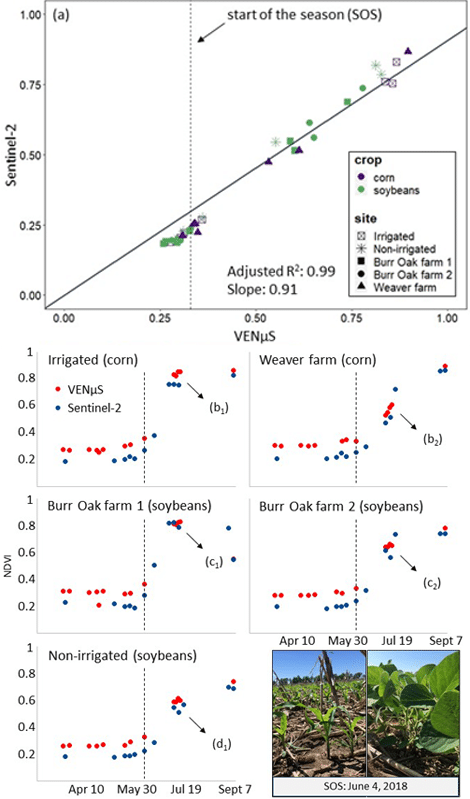
Vegetation Indices from VENμS and Sentinel-2 at Corn and Soybeans in Southwestern Michigan, USA
2Center for Global Change and Earth Observations (CGCEO), Michigan State University, East Lansing, MI
3Department of Biology, University of South Dakota, Vermillion, SD
Vegetation and Environmental New micro Spacecraft (VENμS) is a new hyperspectral satellite equipped with high spatial (~6 m), and temporal (~2 days revisit time) resolution and 12 spectral bands in the visible and near-infrared (e.g., 4 red-edge bands). VENμS is freely available and it has wavelengths similar to Sentinel2, which allows us to compare their applications. Here we investigated VENμS–Sentinel2 for their applications in quantifying vegetation indices (e.g., NDVI) by comparing their spectral reflectance across bands. We compared the NDVI derived from both VENμS and Sentinel2 (level 2A) at five sites in the Kalamazoo watershed of southwestern Michigan, USA. Preliminary results show that during the 2018 growing season, NDVI-VENμS is ~10% higher than that of Sentinel2 (Fig. 1a). Among the corn sites, NDVI showed different values over the growth stage (e.g., mature stage for the irrigated one) (b1). However, while NDVI-Sentinel2 reached the maximum during July 7-13, NDVI-VENμS continued increasing during such period. For the soybeans, both VENμS and NDVI captured a difference of ~0.2 between two varieties of soybeans (c1-c2), while the crop growth trends of two managed sites were similar (d1). Nevertheless, VENμS–Sentinel2 fusion will be needed to provide more accurate estimates of NDVI and its dynamics. Ground-based measurements of vegetation index (i.e., LAI, multispectral reflectance, soil water content) will be collected to validate biophysical modelling.


Powered by Eventact EMS